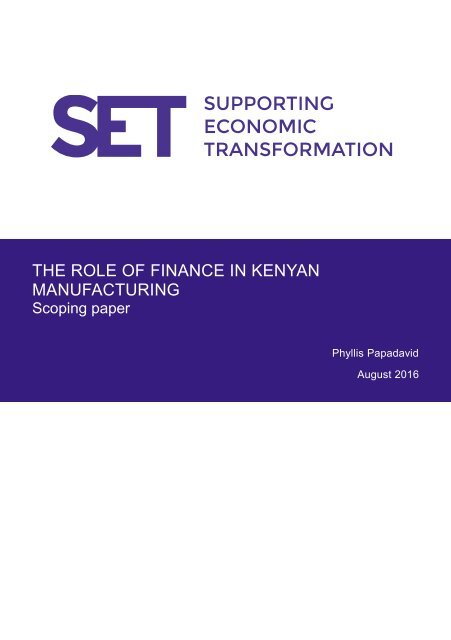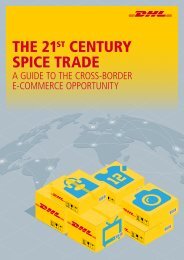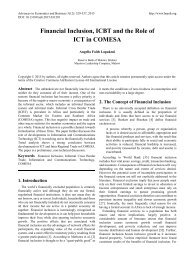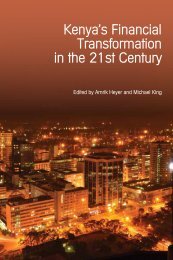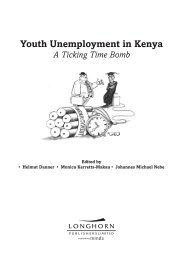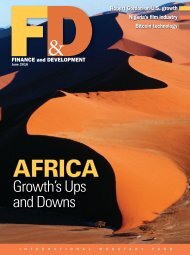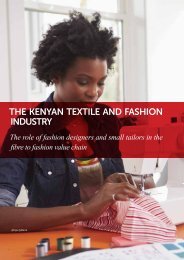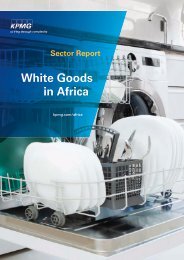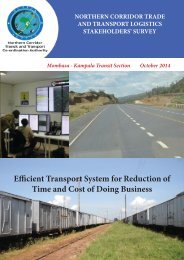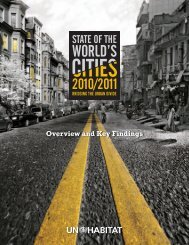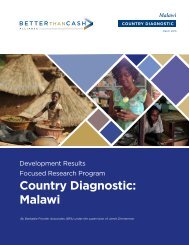THE ROLE OF FINANCE IN KENYAN MANUFACTURING
1TCz304ZfmP
1TCz304ZfmP
You also want an ePaper? Increase the reach of your titles
YUMPU automatically turns print PDFs into web optimized ePapers that Google loves.
<strong>THE</strong> <strong>ROLE</strong> <strong>OF</strong> <strong>F<strong>IN</strong>ANCE</strong> <strong>IN</strong> <strong>KENYAN</strong><br />
MANUFACTUR<strong>IN</strong>G<br />
Scoping paper<br />
Phyllis Papadavid<br />
August 2016<br />
1
<strong>THE</strong> <strong>ROLE</strong> <strong>OF</strong> <strong>F<strong>IN</strong>ANCE</strong> <strong>IN</strong> <strong>KENYAN</strong> MANUFACTUR<strong>IN</strong>G | DRAFT SCOP<strong>IN</strong>G PAPER<br />
Acknowledgements<br />
This paper has been prepared by Phyllis Papadavid (ODI Team Leader in<br />
International Macroeconomics). The author thanks Dirk Willem te Velde for helpful<br />
suggestions. All views expressed are those of the authors alone and do not reflect<br />
DFID or ODI views. For further information about ODI’s SET programme please<br />
contact Sonia Hoque (s.hoque@odi.org.uk), Programme Manager of SET.<br />
© SUPPORT<strong>IN</strong>G ECONOMIC TRANSFORMATION.<br />
The views presented in this publication are those of<br />
the author(s) and do not necessarily represent the<br />
views of DFID or ODI.’<br />
ii
<strong>THE</strong> <strong>ROLE</strong> <strong>OF</strong> <strong>F<strong>IN</strong>ANCE</strong> <strong>IN</strong> <strong>KENYAN</strong> MANUFACTUR<strong>IN</strong>G | DRAFT SCOP<strong>IN</strong>G PAPER<br />
ABBREVIATIONS<br />
AGOA<br />
BIS<br />
CBK<br />
CFSRD<br />
CMA<br />
EAC<br />
FDI<br />
GDP<br />
GEMS<br />
IEA<br />
IFC<br />
IMF<br />
KIPPRA<br />
KNBS<br />
LPO<br />
MSMEs<br />
NGO<br />
NPL<br />
SAP<br />
SMEs<br />
US<br />
WDI<br />
African Growth and Opportunity Act<br />
Bank for International Settlements<br />
Central Bank of Kenya<br />
Comprehensive Financial Sector Reform and Development Strategy<br />
Capital Markets Authority<br />
East African Community<br />
Foreign Direct Investment<br />
Gross Domestic Product<br />
Growth Enterprise Market Segment<br />
Institute of Economic Affairs<br />
International Finance Corporation<br />
International Monetary Fund<br />
Kenya Institute for Public Policy Research and Analysis<br />
Kenya National Bureau of Statistics<br />
Local Purchasing Order<br />
Micro, Small and Medium-Sized Enterprises<br />
Non-Governmental Organisation<br />
Non-Performing Loan<br />
Structural Adjustment Programme<br />
Small and Medium-Sized Enterprises<br />
United States<br />
World Development Indicators<br />
iii
<strong>THE</strong> <strong>ROLE</strong> <strong>OF</strong> <strong>F<strong>IN</strong>ANCE</strong> <strong>IN</strong> <strong>KENYAN</strong> MANUFACTUR<strong>IN</strong>G | DRAFT SCOP<strong>IN</strong>G PAPER<br />
EXECUTIVE SUMMARY<br />
The objective of this scoping paper is to facilitate a discussion to scope out work to enhance Kenya’s<br />
manufacturing performance. Examining the availability of financial products, how to lower manufacturers’<br />
borrowing costs and reducing macroeconomic volatility are potential key areas of focus.<br />
As a part of its Vision 2030 to achieve middle-income status by 2030, the government of Kenya has<br />
specified a number of key sectors that will prove instrumental in reaching its goals. 1 In its plans, the<br />
government has aimed to create a robust, diversified and competitive manufacturing sector. And yet,<br />
growth in manufacturing has proved lacklustre compared with developments in other sectors, such as in<br />
financial services, where there has been significant credit growth. Private sector credit growth has<br />
registered an annual pace of 19.6% between 2011 and 2015 (CBK, 2015b, World Bank, 2015) though<br />
more recently it has slowed. With the economy, and other sub-Saharan African economies facing a ‘credit<br />
crunch’ and a decline in Bank lending (Tyson 2016) amid the global economic slowdown, this paper<br />
assesses the role of finance, and financing constraints, on Kenya’s manufacturing sector.<br />
The financing of Kenya’s small and medium-sized enterprises (SMEs) should be a key focal point for<br />
scoping discussions. Although Kenya’s manufacturing sector is the third largest by contribution to gross<br />
domestic product (GDP), after transport and communication and agriculture and forestry, its share of GDP<br />
has increased only marginally in the past three decades. Access to finance has consistently been cited as<br />
problematic. The key sectors of textiles, together with food processing and the metal industry, have failed<br />
to catalyse broader industrialisation, owing in part to financing constraints. And institutionally, professional<br />
associations have not succeeded in lobbying for improved financing conditions. In Section 1.1 we take<br />
stock of recent developments in Kenya’s manufacturing sector, in Section 1.2 we examine Kenya’s SME<br />
finance and in Section 1.3 we look at how SME finance has fallen short amid the lacklustre performance<br />
of the manufacturing sector.<br />
In the scoping discussions, particular attention should be paid to the obstacles that SMEs face in accessing<br />
finance. Notwithstanding Kenya’s financial sector development, and the growth in SME finance, there has<br />
been uneven provision of finance to Kenya’s manufacturers. The literature suggests that most of Kenya’s<br />
manufacturing companies are small in size and are undercapitalised. There is also evidence that there are<br />
multiple obstacles to obtaining access to finance. These include an over-reliance on bank overdraft<br />
facilities, the high cost of borrowing, a segmented and incomplete financial market and macroeconomic<br />
instability. In Section 2.1 we consider Kenya’s reliance on bank overdraft facilities. In Section 2.2 we<br />
examine the obstacles associated with SME access to finance and in Section 2.3 we consider the role of<br />
Kenya’s informal sector in the context of its manufacturing sector.<br />
A third key discussion point should focus on how Kenya’s relationship with global markets has impacted<br />
its ability to finance its manufacturing sector. The liberalisation of Kenya’s economy was a cornerstone of<br />
its past structural adjustment programmes, with initial liberalisation including looser controls over import<br />
licensing, a relaxing of Kenya’s foreign exchange controls and liberalisation of its petroleum market (IMF,<br />
1996). Notwithstanding the liberalisation of the economy, manufacturing export promotion has not been<br />
successful and inward foreign direct investment in manufacturing remains low. In Section 3 we examine<br />
the impact of Kenya’s trade and investment on its manufacturing sector financing. In Section 3.1 we<br />
consider Kenya’s financial backdrop, characterised by intermittent instability. In Section 3.2 we examine<br />
export promotion policies and in Section 3.3 we evaluate inward investment into the economy.<br />
Section 4 concludes.<br />
1<br />
http://www.vision2030.go.ke/sectors/?sc=9<br />
iv
<strong>THE</strong> <strong>ROLE</strong> <strong>OF</strong> <strong>F<strong>IN</strong>ANCE</strong> <strong>IN</strong> <strong>KENYAN</strong> MANUFACTUR<strong>IN</strong>G | DRAFT SCOP<strong>IN</strong>G PAPER<br />
TABLE <strong>OF</strong> CONTENTS<br />
ABBREVIATIONS ___________________________________ iii<br />
EXECUTIVE SUMMARY _____________________________ iv<br />
1. <strong>IN</strong>TRODUCTION _________________________________ 1<br />
1.1. Kenya’s manufacturing sector: a brief background ___________________________________ 1<br />
1.2. Financing KENYA’s micro, small and medium sized enteprises _________________________ 1<br />
1.3. Kenya’s obstacles to manufacturing growth ________________________________________ 2<br />
2. OBSTACLES TO SME F<strong>IN</strong>ANC<strong>IN</strong>G___________________ 3<br />
2.1 Lack of multiple financial products ________________________________________________ 3<br />
2.1.1. Over-reliance on overdraft facilities _____________________________________________ 3<br />
2.1.2. Institutional obstacles to diversified finance _______________________________________ 3<br />
2.1.3. Limited loan disbursal ________________________________________________________ 4<br />
2.2 Cost of borrowing _____________________________________________________________ 4<br />
2.3. Kenya’s informalisation ________________________________________________________ 4<br />
3. KENYA’S GLOBAL MARKET L<strong>IN</strong>KS __________________ 5<br />
3.1. Kenya’s macroeconomic instability _______________________________________________ 5<br />
3.2. Kenya’s export promotion policies ________________________________________________ 6<br />
3.3. Kenya’s inward financial investment ______________________________________________ 6<br />
4. CONCLUSION ___________________________________ 7<br />
REFERENCES _____________________________________ 9<br />
v
1. <strong>IN</strong>TRODUCTION<br />
Finance helps catalyse savings and deploy capital into investments. Although Kenya’s manufacturing<br />
sector is the third largest in terms of contribution to gross domestic product (GDP), after transport and<br />
communication and agriculture and forestry, its share of GDP has increased only marginally in the past<br />
three decades. Access to finance has consistently been cited as problematic. Textiles, together with food<br />
processing and the metal industry, have been key sectors and yet have failed to catalyse broader<br />
industrialisation, in part because of financing constraints and a lack of institutions that are able to effectively<br />
lobby for an improved investment climate. Here, in Section 1.1 we take stock of recent developments in<br />
Kenya’s manufacturing sector. In Section 1.2 we examine the role of small and medium-sized enterprise<br />
(SME) finance and in Section 1.3 we look at how SME finance has fallen short when held against the<br />
lacklustre performance of the manufacturing sector.<br />
1.1. KENYA’S MANUFACUR<strong>IN</strong>G SECTOR: A BRIEF BACKGROUND<br />
Kenya’s economy registered an average annual growth rate of 5.3% from 2005 to 2015. Growth in services<br />
and in manufacturing has also been commensurate, at 5.7% and 3.7% over the same period, according<br />
to the World Bank’s World Development Indicators (WDI). Over the past three decades, average annual<br />
growth for the manufacturing sector has declined, falling from 11.24% in 1970–9 to 4.8% in 1980–9 and<br />
to 3.2% in the 2000–15 period.<br />
Kenya’s manufacturing sector is the economy’s third largest, according to detailed government sector<br />
splits, and yet its share of GDP has remained stagnant. The sector’s contribution to value addition in<br />
exports is approximately 19%, compared to an approximate 50% share of communications in exports and<br />
a 30% export share for the transport sector (Khanna et al., 2016). More broadly, however, Kenya’s<br />
manufacturing sector has made up a smaller share of the overall economy (13%) compared with the<br />
services sector (52%) and with agriculture (28%) for the 2000-2015 period.<br />
Over the past three decades, the manufacturing sector’s share of the total economy has largely remained<br />
stagnant, with the share of manufacturing value added fluctuating around 12%. The World Bank’s World<br />
Development Indicators highlight that there has been minimal increase since the country’s independence<br />
in 1963. The average 11.3% manufacturing share in the decade following Kenya’s 1963 independence<br />
rose to an average 11.5% in 1990-9 and to 12.2% for 2000-2015.<br />
Kenyan manufacturing has been concentrated on textiles, food processing and metal industries. The<br />
promotion of these three subsectors has largely failed to catalyse broader-based industrialisation in the<br />
same way as in other economies (Chemengich, 2013). The textiles industry, which accounts for<br />
approximately 15% of the sector, benefited from the African Growth and Opportunity Act (AGOA), 2 which<br />
helped expand garment exports from $30mn in 2000 to $250mn by 2005 (KIPPRA, 2009).<br />
Additionally, other low value-added sectors have also seen significant growth. Kenya’s food processing<br />
industry comprises a significant (32%) share of Kenyan manufacturing production, in part because of<br />
Kenya’s agriculture sector. Additionally, Kenya’s dairy, pharmaceuticals and fabricated metal industries<br />
have seen double-digit growth rates. Global demand has proven important: 40% of exports go to the East<br />
African Community (EAC), with 60% exported to South Africa, China and Italy (World Bank, 2014).<br />
1.2. F<strong>IN</strong>ANC<strong>IN</strong>G KENYA’S MICRO, SMALL AND MEDIUM SIZED ENTEPRISES<br />
Kenya’s micro, small and medium-sized enterprise (MSME) 3 sector is growing in importance. These<br />
businesses are estimated to account for 20% of GDP – 80% of employment – and have the scope to<br />
catalyse further industrialisation in Kenya (Onyango, 2007). The government of Kenya’s Vision 2030,<br />
2<br />
https://agoa.info/about-agoa.html<br />
3<br />
The World Bank defines microenterprises as enterprises with 1–9 employees, small enterprises as having 10–49 employees and medium enterprises as having<br />
50–249 employees (Kushnir et al., 2010).<br />
1
<strong>THE</strong> <strong>ROLE</strong> <strong>OF</strong> <strong>F<strong>IN</strong>ANCE</strong> <strong>IN</strong> <strong>KENYAN</strong> MANUFACTUR<strong>IN</strong>G | DRAFT SCOP<strong>IN</strong>G PAPER<br />
which critically also aims to double the share of manufacturing value-added to 20% from 10%, has also<br />
prioritised MSME sector growth.<br />
Financing Kenya’s MSME sector has also grown in importance. Small and medium enterprise (SME)<br />
finance is growing at a relatively fast rate and now represents a growing share of domestic commercial<br />
banks’ lending portfolios. According to the Central Bank of Kenya, total SME lending rose from a 19.5%<br />
share of total lending in 2009 (KSh133 billion) to a 23.4% share (KSh332 billion) in December 2013<br />
(Central Bank of Kenya 2015a).<br />
The market for SME finance is growing rapidly in most sectors of the economy. In Kenya’s construction<br />
sector, SME lending comprises anywhere from 6.5% to 7.8% of total loans. The real estate sector has a<br />
wider dispersion of MSME loan shares, depending on the size of the business. The range is from a 0.8%<br />
share of MSME lending for microenterprises to a 20% share for large enterprises. Manufacturing sector<br />
MSME loan shares range from 6.8% for microenterprises to 15.2% for larger enterprises (CBK, 2015a).<br />
Domestic banks, rather than foreign banks, are increasingly driving SME lending. Since the 2008 financial<br />
crisis, foreign banks have scaled back their exposure: their share of SME loans has declined, from 40%<br />
in 2009 to 27% in 2013. The largest domestic SME lending comes from medium-sized banks (46%) and<br />
large banks (38%) rather than smaller banks (18%). Kenyan banks have relatively large exposure to<br />
microfinance, whereas large international banks have fewer, but larger, corporate and mid-corporate<br />
clients (Berg and Fuchs, 2013).<br />
1.3. KENYA’S OBSTACLES TO MANUFACTUR<strong>IN</strong>G GROWTH<br />
Despite Vision 2030’s industrial strategy to double the share of manufacturing output to 20%, growth in<br />
the manufacturing sector has stagnated. Kenya’s services sector growth has made it East Africa’s<br />
‘financial hub’, partly reflecting the Comprehensive Financial Sector Reform and Development Strategy<br />
(CFSRD). Bank finance has supported Kenya’s MSME sector. And yet, despite this, the majority of SMEs<br />
are unlikely to survive past five years (Katua, 2014), the development of SME industrial parks has fallen<br />
behind and manufacturing growth remains weak (Khanna et al. 2016).<br />
Relatively small firm size and low intra-firm productivity differentials have been dominant influences in<br />
Kenya’s manufacturing sector (Lundvall and Battese, 2007). Firms’ small size means entrepreneurs face<br />
undercapitalisation and little scope for transformation more acutely (Issakson and Wihlborg, 2002). This<br />
has a negative knock-on effect on their access to finance and prevents industrial development and<br />
consequently export growth for the sector (Graner and Issakson, 2002).<br />
Relative labour productivity in Kenya’s manufacturing sector is low (0.9) compared with its services sector,<br />
such as finance and business activities (6.7). 4 This differential has owed, in part, to the persistently low<br />
level of capital intensity (and, in some cases, low wage levels) as well as problems related to the education<br />
and training of management (Heshmati and Rashidghalam, 2016). Additionally, unreliable access to<br />
finance for MSMEs has also been consistently cited as problematic by entrepreneurs in surveys (CBK,<br />
2015a; Soderbom, 2001).<br />
When it comes to Kenya’s textiles sector in particular, there has been both institutional and policy failure,<br />
which has exacerbated financing challenges. The mishandling of cotton marketing boards, failure to<br />
promote backward linkages and poor cotton mill management have been limiting factors (IEA 2006, IMF<br />
2005). Producer associations have not coordinated to lobby for a better investment climate, according to<br />
the African cotton and textile industries federation (ACTIF). From a financing perspective, high overhead<br />
(and thus financing) costs, lack of collateral and little access to funding (just to lower value-added parts of<br />
the value chain), have also restrained production (Chemengich, 2013).<br />
A wide variety of obstacles have been cited as factors standing in the way of manufacturing sector growth<br />
and its underperformance relative to the rest of Kenya’s economy. Chief among these obstacles have<br />
been limited access to the type of long-term finance (and requisite financial services) that can facilitate<br />
successful industrialisation. What has been largely available to Kenya’s MSMEs has largely consisted in<br />
mainly short- and medium-terms loans (IMF, 2005, 2010); the time horizon of these is insufficient to support<br />
4<br />
Labour productivity estimates by sector are calculated relative to country average (Khanna et al., 2016)<br />
2
<strong>THE</strong> <strong>ROLE</strong> <strong>OF</strong> <strong>F<strong>IN</strong>ANCE</strong> <strong>IN</strong> <strong>KENYAN</strong> MANUFACTUR<strong>IN</strong>G | DRAFT SCOP<strong>IN</strong>G PAPER<br />
industrial development, which requires long-term financing. This raises the importance of SME finance<br />
and the obstacles to obtaining it, which we explore in Section 2.<br />
2. OBSTACLES TO SME F<strong>IN</strong>ANC<strong>IN</strong>G<br />
Notwithstanding Kenya’s financial sector development, and the growth in SME finance, there has been<br />
uneven provision of finance to Kenya’s manufacturing MSMEs. Surveys suggest most of Kenya’s<br />
manufacturing MSMEs are small in size and undercapitalised and face multiple obstacles to obtaining<br />
finance. These obstacles include a lack of financial products, a prohibitively high cost of borrowing, a<br />
segmented and incomplete financial market and macroeconomic instability. In Section 2.1 we consider<br />
Kenya’s overreliance on bank overdraft facilities. In Section 2.2 we examine the high cost of borrowing as<br />
an obstacle to SME finance and in Section 2.3 we consider Kenya’s informalisation in the context of its<br />
manufacturing sector.<br />
2.1 LACK <strong>OF</strong> MULTIPLE F<strong>IN</strong>ANCIAL PRODUCTS<br />
2.1.1. OVER-RELIANCE ON OVERDRAFT FACILITIES<br />
Kenyan SME finance is largely sourced from bank overdraft facilities. The total SME lending portfolio<br />
represents approximately 23.4% of the banks’ total loan portfolios, and the majority of these SME loans<br />
are sourced from overdraft facilities. 5 These facilities can be useful as an option to easily access sources<br />
of liquidity for smaller SMEs, which need this liquidity for working capital to function. They offer an<br />
alternative to informal, costlier and unregulated lenders.<br />
Overdraft facilities are problematic for a number of reasons. First, they are easily callable, short-term,<br />
facilities that suit banks, rather than MSME’s longer-term investment funding needs. As such, they reflect<br />
risk aversion on the part of the commercial bank lender which might be cautious in its exposure to smaller<br />
and microenterprises, particularly given difficulties in loan recovery 6 . Overdraft facilities are also<br />
problematic because they provide no information as to why firms are borrowing, or how the loans are<br />
employed.<br />
The overreliance on overdrafts limits MSME longer-term investment. Typically, large financial markets are<br />
characterised by a wide variety of lending products with different levels of maturity (Beck et al., 2009, BIS,<br />
1999). Kenya’s range of financing products for manufacturers is relatively limited. New loan and trade<br />
finance products, such as local purchasing orders (LPO) 7 have largely helped vendors’ obtain the capital<br />
required to execute individual purchase orders (Beck et al., 2010).<br />
2.1.2. <strong>IN</strong>STITUTIONAL OBSTACLES TO DIVERSIFIED <strong>F<strong>IN</strong>ANCE</strong><br />
Institutionally, Kenya’s limited growth in new financial products stems from the ambiguous treatment and<br />
application of the rules in using them. Asset-backed finance SME products, such as factoring and financial<br />
leasing, whereby one party (the lessor) provides an asset for use to another party (the lessee), is illustrative<br />
of this (IFC, 2009). Kenya introduced such measures through its Hire Purchase Act, and subsequent<br />
legislation, enabling the procurement of key inputs, such as machinery, for entrepreneurs in their<br />
production process. However, there has been ambiguous treatment of leasing 8 in that it has been used for<br />
speculative rather than productive purposes (CBK, 2015a).<br />
Accessibility of debt and equity finance is still limited to Kenya’s larger SMEs. Only larger Kenyan<br />
companies are able to source market-based funds, despite the growth in the economy’s broader financial<br />
market. The Nairobi Securities Exchange is the second oldest in sub-Saharan Africa and, at around<br />
KSh2,452bn, the current value of listed securities is nearly half of Kenya’s GDP (CMA, 2015). Launched<br />
in February 2013, the Growth Enterprise Market Segment (GEMS) focuses on SMEs and has lower<br />
5<br />
http://blogs.worldbank.org/psd/smes-are-good-business-kenya-s-growing-banking-sector<br />
6<br />
In Kenya, it takes an average 190 days to recover a bad loan, with the share of recovery around 80 per cent. This compares with Rwanda’s average 135 days to<br />
recover a bad loans, with the share of recovery around 85 per cent (Central Bank of Kenya 2015a).<br />
7<br />
In LPO financing, banks provide loans to firms that obtain purchasing orders from companies and require working capital to execute them:<br />
http://nationalbank.co.ke/business-banking/trade-finance/local-purchase-order-lpo-financing/<br />
8<br />
http://www.businessdailyafrica.com/Opinion-and-Analysis/How-commercial-banks-are-killing-leasing-industry/539548-2140402-ham4h9/index.html<br />
3
<strong>THE</strong> <strong>ROLE</strong> <strong>OF</strong> <strong>F<strong>IN</strong>ANCE</strong> <strong>IN</strong> <strong>KENYAN</strong> MANUFACTUR<strong>IN</strong>G | DRAFT SCOP<strong>IN</strong>G PAPER<br />
capitalisation requirements. And yet this alternative market is still restricted to the higher-end SMEs and<br />
is not available to the majority of Kenyan SMEs.<br />
2.1.3. LIMITED LOAN DISBURSAL<br />
A number of factors shape the ability of Kenya’s manufacturers to borrow and take out loans. Kenyan<br />
MSME borrowers have generally had more success in borrowing from a wide variety of sources, including<br />
cooperatives, which are linked through professional association, such as xxx and xxx, rather than from<br />
more formalised institutional lenders and banks. This suggests that credit rating agencies may have<br />
difficulty in terms of risk assessment capabilities for micro-credit institutions (Green et al., 2007).<br />
The general performance, and permanence, of the business seems to be most important in determining<br />
the success rate of MSME borrowing. This is both for initial capital for a firm, and for additional capital for<br />
existing firms. This suggests that there are few substantive differences among financing decisions, when<br />
comparing MSME business start-ups and established MSMEs. However, the former receive extra<br />
assistance from non-governmental organisations (NGOs) and donor-funded public-private partnerships. 9<br />
There is also some evidence that the availability of credit for small businesses may have improved over<br />
time, although access remains limited. One of the key determinants in the disbursal of loans, and in the<br />
debt and screening decisions of commercial banks, has been the level of education and technical training<br />
of the owners. Managerial education has a significant and positive impact on the probability of borrowing<br />
and on the gearing level (CBK, 2015a, Green et al., 2007).<br />
2.2 COST <strong>OF</strong> BORROW<strong>IN</strong>G<br />
Overreliance on overdraft facilities is problematic given that it is costly and prohibitively expensive for<br />
specific business investment funding needs, and it exposes MSMEs to further funding costs in the form of<br />
interest rate rises. According to CBK data, the average annual interest rate on overdrafts was 18% in<br />
June. 10 In the absence of other financial products, there is little impetus for commercial banks to reduce<br />
firms’ reliance on overdrafts, given that they generate high profit margins.<br />
The range of borrowing costs has remained high for the spectrum of Kenya’s MSMEs. In a joint study with<br />
the World Bank, CBK (2015a) finds that the average annual interest rate is 20.6% for microenterprises,<br />
18.5% for small enterprises, 17.4% for medium enterprises and 15.3% for large enterprises.<br />
From a regional perspective too, financing costs have been an obstacle. In Kakamega municipality,<br />
MSMEs utilise multiple sources of income, including loan facilities at commercial banks and microfinance<br />
institutions, with more than 90% of SMEs that sought formal financing succeeding. And yet SME managers<br />
indicate that the cost of financing is a major impediment (Kihimbo et al., 2012).<br />
Limited competition in Kenya’s banking system has prevented cost reductions. The six largest banks own<br />
approximately 53% of total assets, compared with the 11% share controlled by the country’s small banks.<br />
Assets owned by domestic mid-sized banks (21.6%) are at par with those owned by large foreign<br />
institutions (23.2%). This is important: it is the former that offer low rates to micro and small firms, whereas<br />
Kenya’s foreign banks offer lower rates only to the larger firms (CBK, 2015a).<br />
2.3. KENYA’S <strong>IN</strong>FORMALISATION<br />
Both Kenya’s informational asymmetries and the informalisation in its economy have restrained growth<br />
and expansion in MSME finance. High borrowing costs stem in part from lack of adequate information<br />
about borrowers, and this has been applicable in Kenya’s case (FSD Kenya, 2009). Some of Kenya’s<br />
informational asymmetries owe, still, to its growing financial market: among other things, developed<br />
financial markets increase information exchange, thus reducing transaction costs, and reduce economic<br />
volatility by providing new financial instruments to manage risk, insure against shocks and smooth<br />
investment decisions (IMF, 2016).<br />
9<br />
An example of this is the African Development Bank’s Africa Guarantee Fund for SMEs: http://www.afdb.org/en/topics-and-sectors/initiatives-partnerships/africanguarantee-fund-for-small-and-medium-sized-enterprises/<br />
10<br />
https://www.centralbank.go.ke/index.php/balance-of-payment-statistics/interest-rates-2<br />
4
<strong>THE</strong> <strong>ROLE</strong> <strong>OF</strong> <strong>F<strong>IN</strong>ANCE</strong> <strong>IN</strong> <strong>KENYAN</strong> MANUFACTUR<strong>IN</strong>G | DRAFT SCOP<strong>IN</strong>G PAPER<br />
The high cost of finance is also linked to the lack of firm-specific information on individual Kenyan MSME<br />
characteristics and needs (Migiro and Wallace, 2006). This includes the poor quality of financial records<br />
and an inadequate (or lack of) collateral. Given this, they are seen as dangerous because of the lack of<br />
risk appraisal and management processes. The implication, therefore, is that these firms do not have<br />
adequate credit or collateral to meet the needs at different levels of growth. Owing to the problems<br />
associated with accessing alternative credit facilities, a large proportion of Kenyan SMEs rely more on<br />
self-financing, in terms of retained earnings, or look to external sources (Atieno, 2009).<br />
Effective information exchange between smaller firms has been an institutional restraint to increasing the<br />
SME information base. Although clustering, or a geographic concentration of economic activity, is common<br />
in Kenya, heightened information exchange that catalyses mutual action, for example sub-contracting and<br />
technical innovation, such as that seen in South-East Asia (Barr, 1998), is lacking. For the associations<br />
that do exist, small Kenyan businesses tend to join smaller ones. Although there is recognition of positive<br />
knowledge ‘spill-over’, smaller firm members with few resources typically shy away from joining owing<br />
membership costs (Okech et al., 2002).<br />
Kenya’s largest manufacturing subsector, in food and agri-business, is highly informalised and coexists<br />
alongside the more formalised service sector segments of Kenya’s economy. It consists of semi-organised,<br />
unregulated, small-scale activities that use low-grade technology and contributes the largest share of<br />
manufacturing output (approximately 23%). The formal, or organised, sector is relatively small, with<br />
correspondingly few players: the immigrant entrepreneurial community, which tends to live in close<br />
proximity and look to personal, rather than formal or commercial, finance and savings to finance their<br />
entrepreneurial activity (IMF, 2005, 2010).<br />
3. KENYA’S GLOBAL MARKET L<strong>IN</strong>KS<br />
Kenya’s relationship with global markets has seen intermittent volatility and has lacked appropriate policy<br />
coordination, which has limited the flow of finance to manufacturing. Kenya’s economic liberalisation has<br />
been a cornerstone of its past structural adjustment programmes (SAPs), including loosening import<br />
licensing regulation, relaxing foreign exchange controls and liberalising the petroleum market (IMF, 1996).<br />
Notwithstanding the liberalisation of Kenya’s economy, its export promotion has not been seen as<br />
successful, and inward foreign direct investment (FDI) into manufacturing remains low. In this section we<br />
examine the impact of Kenya’s trade and investment on its manufacturing sector financing. In Section 3.1<br />
we consider Kenya’s financial backdrop, characterised by intermittent macroeconomic instability. In<br />
Section 3.2 we examine its export promotion policies and in Section 3.3 we evaluate inward investment<br />
into the economy.<br />
3.1. KENYA’S MACROECONOMIC <strong>IN</strong>STABILITY<br />
Intermittent macroeconomic volatility has been a notable factor limiting the development of Kenya’s<br />
manufacturing sector. Macroeconomic factors, such as interest rate and currency volatility, have been<br />
identified as the second most significant impediment to sub-Saharan African SMEs more generally (Calice<br />
et al., 2012). In Kenya, this is exacerbated by the difficulty in managing this risk amid liberalised (and<br />
mobile) cross-border portfolio investment and FDI flows, a freely floating exchange rate and Kenya’s<br />
particular destination as a financial ‘hub’ (Tyson, 2016).<br />
In the most recent period, following the 2009 financial crisis, Kenya saw heightened macroeconomic<br />
instability. The CBK raised interest rates in order to counter the inflationary impact of the shilling<br />
depreciation. In 2011, the Kenyan shilling lost nearly 25% of its value, and inflation accelerated from 6%<br />
to approximately 20% by the end of that year. In an attempt to halt the inflationary spiral, the CBK raised<br />
the Central Bank Rate from 6.25% to 18%. Some stabilisation occurred: at the start of 2013, Kenya’s<br />
inflation fell below 5% and the Kenyan shilling stabilised in value.<br />
Both changes in the Kenyan shilling/US dollar exchange rate and inflationary episodes have been found<br />
to influence Kenya’s private sector credit growth, particularly in the past two decades (Washington, 2014).<br />
Macroeconomic instability has impacted loan provision: banks’ total annual loan growth halved from 30.2%<br />
in 2011 to 14.3% in 2012. Although the ratio of non-performing loans (NPLs) dropped from 35% of gross<br />
5
<strong>THE</strong> <strong>ROLE</strong> <strong>OF</strong> <strong>F<strong>IN</strong>ANCE</strong> <strong>IN</strong> <strong>KENYAN</strong> MANUFACTUR<strong>IN</strong>G | DRAFT SCOP<strong>IN</strong>G PAPER<br />
loans in 2003 to 4.4% in 2011, owing to higher levels of provisioning (CBK, 2015b), after that Kenya’s NPL<br />
ratio edged up to 6% in 2015, which could be exacerbated by incidences of fraud. 11<br />
3.2. KENYA’S EXPORT PROMOTION POLICIES<br />
Under Vision 2030’s goal for a diversified, robust and competitive manufacturing sector, policy-makers<br />
have focused on improving Kenya’s external trade relationship with global markets. Given this, there has<br />
been renewed focus on export-oriented strategies and a greater role for the manufacturing sector in<br />
supporting Kenya’s external trade. Government policy has aimed to incentivise special economic zones<br />
and industrial parks, capitalising on rapid growth in information and communications technology as a key<br />
support for faster industrialisation.<br />
From a financial perspective, although Vision 2030’s main goal has been to improve the overall business<br />
climate, this has been largely incentivised though tax breaks rather than access to finance. Export<br />
processing zones have been successful for the textiles industry. 12 However, the incentives here, which<br />
include a 10-year corporate tax holiday, perpetual exemption from stamp duty (on legal processes) and<br />
100% investment deduction on new investments in buildings and machinery, 13 have catalysed foreign<br />
firms and joint ventures (which comprise over 50% of export processing zones) rather than domestic<br />
manufacturing SMEs.<br />
The liberalisation of Kenya’s foreign exchange market has incentivised inward investment. The<br />
introduction of Foreign Exchange Bearer Certificates in 1991 was a key step, and was followed by the<br />
establishment of a secondary market for the certificates in 1992 with a 100% retention of foreign exchange<br />
earnings from manufactured goods exports (Were et al., 2001). This regime facilitated easier repatriation<br />
of capital and profits, access to foreign currency accounts and both domestic and offshore borrowing.<br />
Despite having liberalised its financial sector, Kenya’s usage of import substitution vis-à-vis its export<br />
promotion policies prevented success of the latter set of reforms. During the SAPs of the 1980s and 1990s,<br />
the government did little to instil export promotion during liberalisation, and manufacturers were unable to<br />
effectively obtain foreign exchange to conduct business, with export compensation claims often delayed,<br />
preventing an effective business climate (IMF, 1996, 2005, 2010).<br />
3.3. KENYA’S <strong>IN</strong>WARD F<strong>IN</strong>ANCIAL <strong>IN</strong>VESTMENT<br />
Fostering foreign investment in Kenya’s manufacturing sector could constitute a key source of finance for<br />
manufacturing MSMEs. Both FDI and portfolio investment could be an important means of financing<br />
Kenya’s manufacturing sector. And yet both types of investment are likely to be held back by nonmanufacturing<br />
investment activity, macroeconomic volatility or both. Kenya’s inward FDI has been strong:<br />
between January and November 2015, FDI rose nearly 37% compared to 2014. 14 And yet recent increases<br />
have been not been linked with manufacturing. As of May 2016, the 47% annual rise in inward FDI has<br />
been comprised of large-scale investments in Kenya’s infrastructure, real estate, renewable and<br />
geothermal energy sectors. 15<br />
Portfolio investment in Kenya’s domestic debt and equity markets is crucial to developing a competitive<br />
banking sector and financial market in Kenya; this would facilitate new sources of finance for firms and for<br />
MSMEs. Macroeconomic instability has the potential knock-on effect of limiting inward foreign investment<br />
in Kenya’s financial system that would have otherwise diversified the sources of finance available. In the<br />
aftermath of the 2009 crisis, although SME lending (as a share of total loans) rose for domestic banks,<br />
foreign bank lending was largely stagnant, falling from 16.6% in 2009 to 16.1% in 2013 as the latter took<br />
a more cautious approach (CBK, 2015a).<br />
Larger sources of finance for Kenya’s businesses remain limited to larger-sized firms, leaving the smaller<br />
and medium-sized firms outside of the scope of their activities. In 2013, 12 new deals worth a total of<br />
US$112mn, were signed in Kenya. Since then, the sectors of focus have been diverse (ranging from<br />
11<br />
http://www.reuters.com/article/kenya-banking-imperial-idUSL8N12S1DS20151028<br />
12<br />
https://agoa.info/news/article/5367-kenya-earns-543m-in-2013-from-export-processing-zones.html<br />
13<br />
http://www.epzakenya.com/index.php/investment-information/incentives.html<br />
14<br />
http://www.fdiintelligence.com/Trend-Tracker/Bumper-year-for-Kenya-destined-FDI?ct=true<br />
15<br />
http://www.nation.co.ke/business/Kenya-posts-fastest-rise-in-foreign-direct-investments/996-3194256-6v1vqz/index.html<br />
6
<strong>THE</strong> <strong>ROLE</strong> <strong>OF</strong> <strong>F<strong>IN</strong>ANCE</strong> <strong>IN</strong> <strong>KENYAN</strong> MANUFACTUR<strong>IN</strong>G | DRAFT SCOP<strong>IN</strong>G PAPER<br />
financial services to agriculture) with Kenya considered the most favoured destination for private equity<br />
investment following South Africa and Nigeria. Notwithstanding this, the majority (of approximately 15–20<br />
active private equity funds) are largely focused on larger SMEs, with financing needs of between<br />
US$50,000 and $5mn (Deloitte & Africa Assets, 2014), leaving out the remainder of Kenya’s SME sector.<br />
At the current juncture, ensuring exchange rate and interest rate stability should be a priority for the Kenyan<br />
government in managing and growing its trade and investment relationships with its trading partners. It<br />
could do so by developing financial instruments to help exporters insure against financial shocks. This<br />
step could be useful in safeguarding against global financial risk aversion stemming from geopolitical<br />
events (such as the US presidential election). Safe haven investment flows back to US-based assets could<br />
see a negative knock-on effect on investments that are seen as risker, including those in sub-Saharan<br />
Africa and in Kenya. 16<br />
4. CONCLUSION<br />
Kenya’s manufacturing sector has been a focus of attention within the government’s Vision 2030 to bring<br />
the economy up to middle-income status by 2030. Notwithstanding preceding attempts to support the<br />
manufacturing sector, growth and productivity have been lacklustre compared with in Kenya’s services<br />
sector. There have been a number of obstacles to development in the sector, chief among them being<br />
limited access to finance.<br />
Although Kenya’s manufacturing sector is the third largest by contribution to GDP, after transport and<br />
communication and agriculture and forestry, its share of GDP has increased only marginally in the past<br />
three decades. Access to finance has consistently been cited as problematic. The key sectors of textiles,<br />
together with food processing and the metal industry, have failed to catalyse broader industrialisation, in<br />
part because of financing constraints.<br />
Notwithstanding Kenya’s financial sector development, and the growth in SME finance, there has been<br />
uneven provision of finance to Kenya’s manufacturers. The literature suggests that most of Kenya’s<br />
manufacturing companies are small in size and undercapitalised. There is also evidence that there are<br />
multiple obstacles to obtaining access to finance. These include reliance on bank overdraft facilities, the<br />
high cost of borrowing, a segmented and incomplete financial market and macroeconomic instability.<br />
This paper has sought to analyse the aspects of access to finance that have proved most problematic. It<br />
looks at specific obstacles to accessing finance that manufacturing SMEs have faced. Access has been<br />
largely prohibited as a result of the high cost of borrowing and the lack of financial products available to<br />
raise finance. It is also related to the limited information available on SMEs, which limits the ability of<br />
commercial banks to assess creditworthiness.<br />
The liberalisation of Kenya’s economy was a cornerstone of its past SAPs. Its early liberalisation under<br />
structural adjustment included a relaxation of import licensing and foreign exchange controls, which<br />
facilitated trade promotion. Notwithstanding this liberalisation of the economy, export promotion has not<br />
been seen as successful and inward FDI in manufacturing remains low.<br />
Kenya’s manufacturing SME access to finance has also been hampered by the country’s weak relationship<br />
with global markets. Macroeconomic volatility, stemming in part from its interest and exchange rate<br />
volatility, has created an uncertain investment climate. Exchange rate depreciations, particularly in the<br />
2011–12 period, have meant that loan growth has slowed as banks have become more cautious, with<br />
incidences of fraud likely to undo some of Kenya’s success in lowering its ratio of NPLs.<br />
The success of Kenya’s export promotion policies has been limited by the dominance of its import<br />
substitution policies and a lack of appropriate macroeconomic management. The government’s focus on<br />
export promotion zones and the tax incentives in place to promote them will be beneficial, but largely for<br />
foreign firms. Focus also needs to be given to supporting domestic SMEs’ access to financial markets,<br />
and the terms (cost) under which they are able to access finance through financial markets.<br />
16<br />
http://www.reuters.com/article/africa-currency-idUSL5E8GHFJ920120517<br />
7
<strong>THE</strong> <strong>ROLE</strong> <strong>OF</strong> <strong>F<strong>IN</strong>ANCE</strong> <strong>IN</strong> <strong>KENYAN</strong> MANUFACTUR<strong>IN</strong>G | DRAFT SCOP<strong>IN</strong>G PAPER<br />
Increasing the manufacturing share of output is important for the government to achieve its Vision 2030<br />
goal of bringing the economy to middle-income status. To successfully double the share of manufacturing<br />
output, to 20% of GDP, the obstacles to finance highlighted in this paper suggest MSME finance needs to<br />
improve. Our scoping paper suggests that increasing the financial products available, lowering borrowing<br />
costs and reducing macroeconomic volatility are potential key areas of focus.<br />
8
<strong>THE</strong> <strong>ROLE</strong> <strong>OF</strong> <strong>F<strong>IN</strong>ANCE</strong> <strong>IN</strong> <strong>KENYAN</strong> MANUFACTUR<strong>IN</strong>G | DRAFT SCOP<strong>IN</strong>G PAPER<br />
REFERENCES<br />
Atieno, R. (2009) Linkages, access to finance and the performance of small-scale enterprises in Kenya. Research<br />
Paper 2009/06. Helsinki: UNU.<br />
Barr, M.A. (1998) Enterprise performance and the functional diversity of social capital. Working Paper 98/1. Oxford:<br />
CSAE.<br />
Beck, T., Kunt-Demirguc, A. and Levine, R. (2009) Financial institutions and markets across countries and over<br />
time. Policy Research Working Paper 4943. Basel: BIS.<br />
Beck, T., Fuchs, M., Getenga, J., Gatere, P., Randa, J. and Trandafir, M. (2010) Banking sector stability, efficiency,<br />
and outreach in Kenya. Policy Research Working Paper 5442. Washington, DC: World Bank.<br />
Berg, G. and Fuchs, M.J. (2013) Bank financing of SMEs in five sub-Saharan African countries: The role of<br />
competition, innovation, and the government. Policy Research Working Paper 6563. Washington, DC: World Bank.<br />
BIS (Bank for International Settlements (1999) Recommendations for the design of liquid markets. CGFS<br />
Publication 13. Basel: BIS.<br />
Calice, P., Chando, V.M. and Sekioua, S. (2012) Bank financing to small and medium enterprises in East Africa:<br />
Findings of a survey in Kenya, Tanzania, Uganda and Zambia. Working Paper 146. Tunis: AfDB.<br />
CMA (Capital Markets Authority) (2015) ‘Quarterly Statistical Bulletin’, Quarter Ending March. Nairobi: CMA.<br />
CBK (Central Bank of Kenya) (2015a) Financing business – supply: Bank financing of SMEs in Kenya. Nairobi:<br />
CBK.<br />
CBK (Central Bank of Kenya) (2015b) ‘Bank supervision annual report 2014’. Nairobi: CBK.<br />
Chemengich, M., with Vaid, V., Olweny, H. and Karuiki, F. (2013) ‘Policy research on the Kenyan textile industry’.<br />
Nairobi: ACTIF.<br />
Deloitte and Africa Assets (2014) ‘2013 East Africa Private Equity Confidence Survey’. Nairobi: Deloitte and Africa<br />
Assets.<br />
FSD Kenya (2009) ‘FinAccess National Survey 2009: Dynamics of Kenya's changing financial landscape’. Nairobi:<br />
FSD Kenya.<br />
Graner, M. and A. Issakson (2002) ‘Export performance’, in A. Bigsten and P. Kimuyu (eds) Structure and<br />
performance of manufacturing in Kenya. London: Palgrave Macmillan.<br />
Green, C.J., Kimuyu, P., Manos, R., and Murinde, V. (2007) ‘How do small firms in developing countries raise<br />
capital? Evidence from a large-scale survey of Kenyan micro and small-scale enterprises’, in J. Hirschey and A.K.<br />
Makhija (eds) Issues in corporate finance and governance: Advances in financial economics. Vol. 2. New York,<br />
Oxford, Paris and San Francisco, CA: Elsevier.<br />
Heshmati, A. and Rashidghalam, M. (2016) Labour productivity in Kenyan manufacturing and service industries.<br />
Discussion Paper 9923. Bonn: IZA.<br />
IEA (Institute of Economic Affairs) (2006) ‘Trade policy reforms and poverty in the cotton sub-sector: Challenges<br />
and policy issues’. Policy Brief 5. London: IEA.<br />
IFC (International Finance Corporation) (2009) Leasing in development: Guidelines for emerging economies.<br />
Washington, DC: IFC Advisory Services.<br />
IMF (International Monetary Fund) (1996) Enhanced Structural Adjustment Facility policy framework paper, 1996–<br />
1998. Washington, DC: IMF.<br />
IMF (International Monetary Fund) (2005) Kenya: Poverty Reduction Strategy Paper. Country Report 05/11.<br />
Washington, DC: IMF.<br />
IMF (International Monetary Fund) (2010) Kenya: Poverty Reduction Strategy Paper. Country Report 10/224.<br />
Washington, DC: IMF.<br />
IMF (International Monetary Fund) (2016) ‘Sub-Saharan Africa: Time for a policy reset’, Regional Economic<br />
Outlook, World Economic and Financial Surveys, April 2016. Washington, DC: IMF.<br />
Issakson, A. and Wihlborg, C. (2002) ‘Financial constraints on Kenyan manufacturing’, in A. Bigsten and P. Kimuyu<br />
(eds) Structure and performance of manufacturing in Kenya. New York: Palgrave Macmillan.<br />
9
<strong>THE</strong> <strong>ROLE</strong> <strong>OF</strong> <strong>F<strong>IN</strong>ANCE</strong> <strong>IN</strong> <strong>KENYAN</strong> MANUFACTUR<strong>IN</strong>G | DRAFT SCOP<strong>IN</strong>G PAPER<br />
Katua, N.T. (2014) ‘The role of SMEs in employment creation and economic growth in selected countries’,<br />
International Journal of Education and Research 2(12): 461–72.<br />
Khanna, A., Papadavid, P., Tyson, J. and te Velde, D.W. (2016) The role of services in economic transformation –<br />
with an application to Kenya. London: SET, ODI.<br />
Kihimbo, B.W., Ayako, B.A., Omoka, K.W. and Otuya, W.L. (2012) ‘Financing of small and medium sized<br />
enterprises (SMEs) in Kenya: A study of selected SMEs in Kakamega municipality’, International Journal for<br />
Current Research 4(4): 303–9.<br />
Kimuyu, P. (2010) ‘Do small firms in developing countries ever transform?’ Regional Development Studies 14: 11–<br />
28.<br />
KIPPRA (Kenya Institute for Public Policy Research and Analysis) (2009) Kenya Economic Report 2009: Building a<br />
globally competitive economy. Nairobi: KIPPRA.<br />
Kushnir, K., Mirmulstein, M.L. and Ramalho, R. (2010) ‘Micro, small and medium enterprises around the world:<br />
How many are there, and what affects the count?’ World Bank/IFC MSME Country Indicators. Washington, DC:<br />
IFC.<br />
Lundvall, K. and Battese, G.E. (2007) ‘Firm size, age and efficiency: Evidence from Kenyan manufacturing firms’,<br />
Journal of Development Studies 36(3): 146–63.<br />
Migiro, S.O. and Wallis, M. (2006) ‘Kenyan manufacturing SMEs finance needs to information on alternative<br />
sources of finance’, SA Journal of Information Management 8(1): doi: 10.4102/sajim.v8i1.218<br />
Okech, B., Mitullah, W. and Atieno, R. (2002) ‘Understanding business systems in Kenya: Firm response to<br />
changing market environment in the metal products sector’, Regional Workshop on Business Systems in Africa,<br />
Nairobi, 15–16 April.<br />
Onyango, M. (2007) ‘Federation of Kenyan Employers SME Project’, Interregional Symposium on the Informal<br />
Economy – Enabling Transition to Formalization, Geneva, 27–9 November.<br />
Soderbom, M. (2001) Constraints and opportunities in Kenyan manufacturing: Report on the Kenyan Manufacturing<br />
Enterprise Survey 2000. Vienna: UNIDO.<br />
Tyson, J. (2016) Sub-Saharan Africa’s economic downturn and its impact on financial development. Working Paper<br />
440. ODI Shockwatch Bulletin. London: ODI.<br />
Washington, G.K. (2014) ‘Effects of macroeconomic variables on credit risk in the Kenyan banking system’,<br />
International Journal of Business and Commerce 3(9).<br />
Were, M., Geda, A., Karingi, S.N. and Ndung’u, N.S. (2001) Kenya’s exchange rate movement in a liberalized<br />
environment: An empirical analysis. Discussion Paper 10. Nairobi: KIPPRA.<br />
World Bank (2014) ‘Anchoring high growth: Can manufacturing contribute more?’ Kenya Economic Update 11,<br />
December. Washington, DC: World Bank.<br />
10


